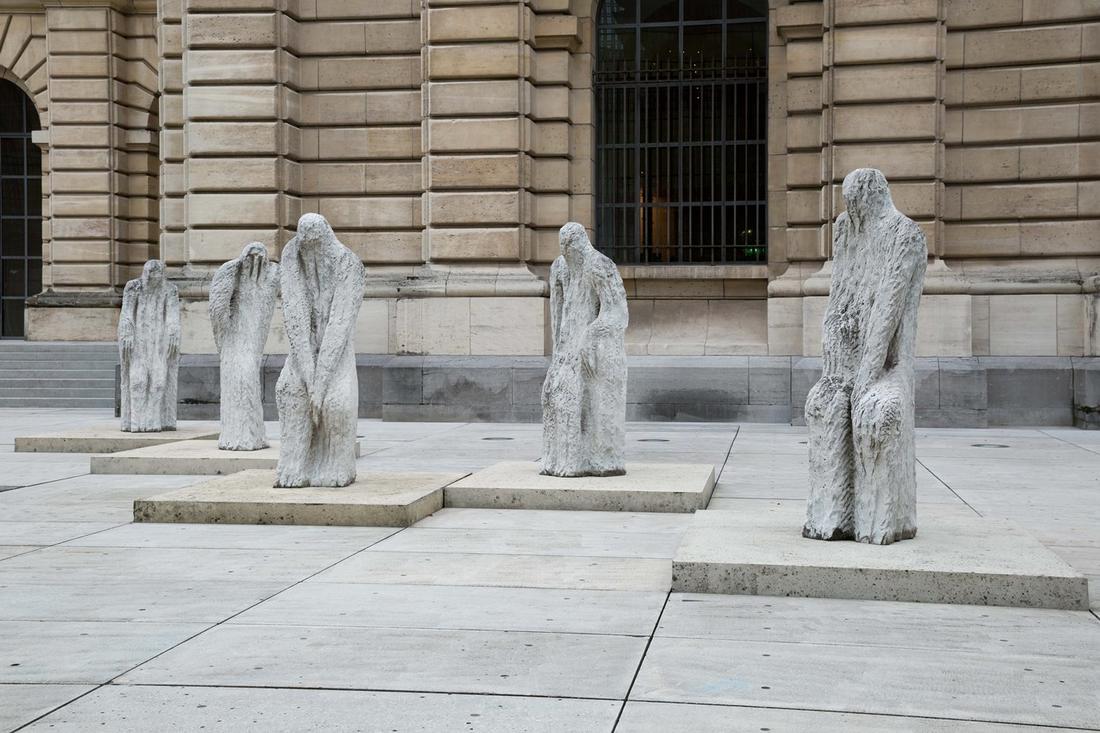There are five of them. Five ghostly figures, all facing in the same direction. It seems as though they want to move forward, but the weight of the stone keeps them grounded!
Like all of Eugène Dodeigne's figures, these sculptures are simply sketched. He is not concerned with showing a precise face or anatomy. Nevertheless, the bodies of this “Group of Five” are expressive; one is shown frontally, another is leaning forward. Another is twisted, or has a square back, or joined hands.
It is precisely the absence of detail that allows the viewer to imagine the faces of these figures, rather than see them.
Unlike other artists, Dodeigne does not polish the surface of his sculptures, leaving them in their raw state. You can even see the marks left by his tools.
Although Dodeigne usually uses dark blue Soignies stone, for the “Group of Five” he prefers white marble from Carrara, Italy. This hard stone requires a long process of roughing out; first, Dodeigne carves parallel grooves into the marble, from which he chips away pieces of stone. This is called direct carving. Next, he uses a rotating disc to define the shapes of the figure. Finally, he uses metal points to create the details of the work. A long and meticulous process for a spectacular result!
Detail 1: On Place de la République, on the other side of the museum, there is a fountain decorated with the “Group of Three” by Dodeigne.
Detail 2: Dodeigne creates his sculptures based on the shape of the stone block. But he can also draw inspiration from a drawing. The museum thus preserves, in the Drawing Room, a study for the “Group of Five.”

There are five of them. Five ghostly figures, all facing in the same direction. It seems as though they want to move forward, but the weight of the stone keeps them grounded!
Like all of Eugène Dodeigne's figures, these sculptures are simply sketched. He is not concerned with showing a precise face or anatomy. Nevertheless, the bodies of this “Group of Five” are expressive; one is shown frontally, another is leaning forward. Another is twisted, or has a square back, or joined hands.
It is precisely the absence of detail that allows the viewer to imagine the faces of these figures, rather than see them.
Unlike other artists, Dodeigne does not polish the surface of his sculptures, leaving them in their raw state. You can even see the marks left by his tools.
Although Dodeigne usually uses dark blue Soignies stone, for the “Group of Five” he prefers white marble from Carrara, Italy. This hard stone requires a long process of roughing out; first, Dodeigne carves parallel grooves into the marble, from which he chips away pieces of stone. This is called direct carving. Next, he uses a rotating disc to define the shapes of the figure. Finally, he uses metal points to create the details of the work. A long and meticulous process for a spectacular result!
Detail 1: On Place de la République, on the other side of the museum, there is a fountain decorated with the “Group of Three” by Dodeigne.
Detail 2: Dodeigne creates his sculptures based on the shape of the stone block. But he can also draw inspiration from a drawing. The museum thus preserves, in the Drawing Room, a study for the “Group of Five.”